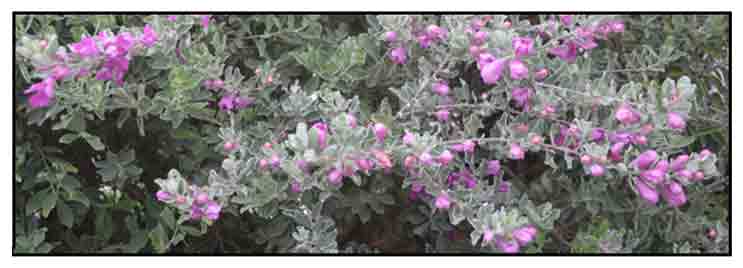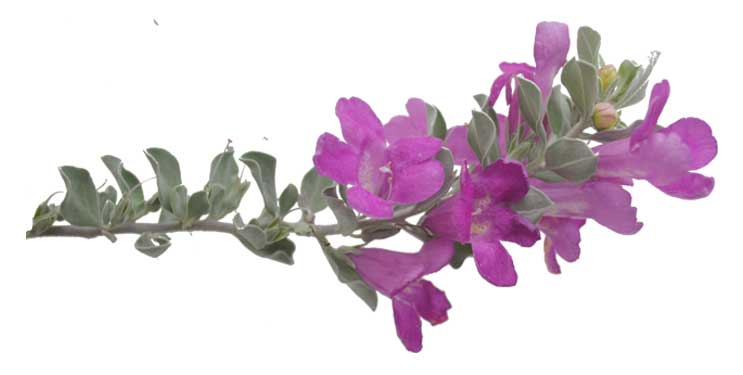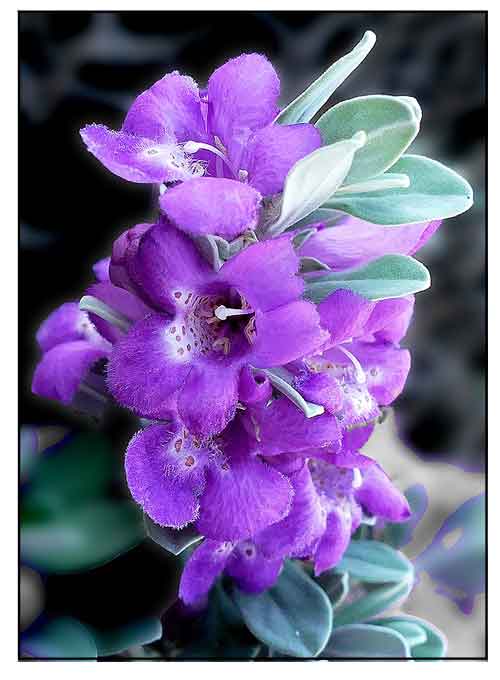 Gen info Gen info
- Leucophyllum (barometer bush) is a genus of evergreen shrubs in the figwort family, Scrophulariaceae, native to the southwestern United States and Mexico. It contains a dozen-odd species often called "sages", although they are not true sages, and unrelated to the genus Salvia. (20)
- Etymology: The genus name Leucophyllum derives from Greek words leukos, meaning "white", and phyllos, meaning "leaf, referring to the trichome-covered foliage.
-
Called Barometer Bush because flowers bloom magnificently after rains due to humidity and soil moisture. They are also known for their ability to "forecast" rain, usually blooming several days prior to a rainstorm, apparently in response to humidity. (20)
- It is native to the U.S. state of Texas, where it is the official "State Native Shrub of Texas". (21)
 Botany Botany
Silverleaf is a dense evergreen shrub from 2 to 5 feet tall, occasionally reaching 8 feet in height, with is leaves covered with stellate, silvery hairs and bright pink-lavender, bilaterally symmetrical flowers borne singly in crowded leaf axils. Leaves are silver gray to greenish, soft to touch, up to 1 1/4 inches long or less, tapering gradually to the base, with rounded tip, and smooth margins. Flowers are violet to purple, sometimes pink, bell-shaped, about 1 inch in length and width. Fruit is a small capsule. (2)
Note:
•
Sage attribution has erroneously been given to silverleaf—Texas sage, purple sage, Silverado sage. It is not a true sage but a leucophyllum and a member of the Scrophylariaceae family. It lacks the square stems and aroma of typical sage. It is more closely related to snapdragons. (7)
Distribution
- Introduced.
- Native range is SW Texas to Mexico.
-
Widely cultivated in Florida and Southeast Asia.
- Popular as ornamental and hedge plant.
 Constituents Constituents
- Contain high amounts of C, with a high C/N ratio.
- Study on leaves yielded: (macro-nutrients) K 0.8 ± 0.10 mg/g-1 dw, Mg 2.69 ± 0.28 mg/g, P 13.69 ± 3.10, C 14.6 %. N 49.97 ±0.04 %, C:N
2.25 ±0.27; (micronutrients) Cu 6.45 ±0.79 µgg-1 dw, Fe 118.12 ± 15.44 µgg-1 dw, Zn 27.23 ± 3.79 µgg-1 dw.
- Bioassay-guided fractionation of hexane:acetate (1:1) extract of leaves of Leucophyllum frustescens isolated phytotoxic constituents diayangambin (1), epiyangambin (2), diasesartemin (3), and epiashantin (4).
(see study below) (11)
- GC-MS analysis of volatile components of leaves and flowers identified 30 compounds, with major components of 1-octen-3-ol (73/56%) and D-limonene (11.12%) in the leaves, and n-heneicosane (32.30%) and dehydroepingaione (15.15%) in the flowers. (see study below) (12)
- GC-MS profiling of hexane leaf extract of aerial parts revealed The chemical profiling by GC–MS analysis revealed 9-octadecenoic acid (Z)-, methyl ester, pentadecanoic acid, 14-methyl-, methyl ester, 2,6-bis(3,4-methylenedioxyphenyl)-3,7-dioxabicyclooctane, (+)-sesamin, 9,12-octadecadienoic acid, methyl ester, 9,12,15-octadecatrienoic acid, ethyl ester, (Z,Z,Z)-, n-hexadecanoic acid, hexadecanoic acid, ethyl ester, phytol, methyl stearate, cyclohexanone, 1H,3H-Furo[3,4-c]furan, 1,4-bis(3,4-dimethoxy phenyl)tetrahydro-, [1R-(1.alpha.,3a.alpha.,4.alpha.,6a.alpha.)]-, and squalene. (see study below) (13)
- Phytochemical quantifications revealed high TPC in the butanol leaf extract (189.369 mg GAE /gm and high TFC with the chloroform leaf extract (232.458 mg QE/g). (see study below) (13)
 Properties Properties
- Thrives in challenging desert environments.
-
Studies suggest antimicrobial, antituberculous, cytotoxic, antimitotic, phytotoxic, hepatoprotective properties.
Parts used
Leaves, aerial parts.
Uses
Edibility
- Dried leaves and flowers can be brewed into an herbal tea. It has been reported to have mildly sedative effects.
Folkloric
- No known medicinal use in the Philippines.
- In northeast Mexico, used for bronchitis and lung complaints, including tuberculosis, diarrhea, liver, fever, and jaundice.
- Decoction of leaves used as tea for treating lung congestion, bronchitis, chills, and fever associated with colds.
- In American and Mexican folk medicine, crude drug used for treatment of various respiratory disorders, dysentery, cataract, and liver disorders. (13)
Others
- Host plant: It is host plant for the caterpillars of the theona checker spot (Chlosyne theona) and calleta silkmoth (Eupackardia calleta). (13)
Studies
• Hepatoprotective / Aerial Parts: Study evaluated the hepatoprotective efficacy of L. frutescens aerial parts in a model of hepatotoxicity induced by carbon tetrachloride in wistar albino rats. Results showed significant decrease in ALT and AST, less pronounced destruction of liver architecture. Results suggest the methanol extract of aerial parts could be an important source of hepatoprotective compounds. (3)
• Antimicrobial / Cytotoxicity: In a study of five medicinal plants for potential antimicrobial activity, methanol extract of leaves of L. frutescens showed antimicrobial activity against Staphylococcus aureus and Escherichia coli with MIC of 25.0 and 27.1 µg/ml, respectively. In the bioassay with Artemia salina, only the extract of L. frutescens showed toxicity with DL50 of 196.7 µg/ml. (4) In a study of five medicinal plants from Northern Mexico, a methanolic extract of of Leucophyllum frutescens showed antimicrobial activity against S. aureus CI and E. coli 0157 with MICs of 28.0 and 30.0 µg/ml, respectively. (10)
• Antituberculosis Activity / Roots and Leaves: In a study of 14 plants used in northeast Mexico for potential antimicrobial activity, methanol based extracts of roots and leaves showed significant antimicrobial activity against drug-resistant strain of Mycobacterium tuberculosis, with a minimal inhibitory concentration (MIC) of 62.5 and 125 microg/mL. (5)
• Leubethanol / Serrulatane-Type Diterpene / Anti-Tuberculosis: Bioactivity-guided fractionation of methanolic extract of root bark of L. frutescens isolated and identified leubethanol, a new serrulatne-type diterpene with activity against both multi-drug resistant and drug-sensitive strains of virulent Mycobacterium tuberculosis. (6)
• Encapsulation in Polymeric Nanoparticles / Leaves: Study reports on a simple, repeatable, and reproducible methodology for quantifying components of a vegetable material loaded in NP, using a hexane fraction of L. frutescens leaves. The NP-formed polymer and nanoprecipitation method were favorable to encapsulate the hydrophobic components of the L. frutescens extract. (9)
• Phytotoxic / Antimitotic Activity of Furofuran Lignans / Leaves: Bioassay-guided fractionation of hexane:acetate (1:1) extract of leaves of Leucophyllum frustescens isolated phytotoxic constituents diayangambin (1), epiyangambin (2), diasesartemin (3), and epiashantin (4). Phytotoxicity was demonstrated by inhibition of seed germination of Agrostis stolonifera seedlings and inhibition of development of Lactuca sativa seedlings. (11)
• Anti-Aging / Inhibitory Against Elastase and Collagenase / Essential Oil of Leaves and Flowers: Study evaluated the volatile components from leaves and flowers and their anti-aging activity. The essential oil from leaves and flowers showed potential collagenase inhibitory activity with IC50 of 55.7 and 47.4 µg/ml. The oils from leaves and flowers showed moderate anti-elastase activity with IC50 60.8 and 97.7 µg/mL. Results suggest a promising natural anti-aging drug. (12)
• Antioxidant / Antidiabetic / Aerial Parts: Study evaluated polyphenolic contents, antioxidant activities, and antidiabetic enzyme inhibition assays, and GC-MS profiling of aerial parts. Strong inhibition of α-glucosidase and urease enzymes were exhibited by hexane leaf extract (IC50 0.3321 mg/mL) and chloroform leaf extract (IC50 4.711 mg/ml), respectively. The chloroform leaf extract showed highest antioxidant content by TAA, DPPH, TEAC, FRAP and CUPRAC, equivalent to Trolox. Results showed significant antioxidant, antidiabetic and cytotoxic activities with potential for discovery of novel phytochemical products and industrial applications. (see constituents above) (13)
• Silver and Gold Nanoparticles / Catalytic Dye Degradation: Study reports on the phytogenic synthesis of silver (AgNPs) and gold (AuNPs) using Leucophyllum frutescens leaf extract. Bioreduced AgNPs and AuNPs catalytically degraded Rhodamine B dye (RhB) in the presence of UV-light. The remarkable photocatalytic activities of the NPs suggest potential for use in biomedical applications and tissue engineering with respect to photothermal and photodynamic therapy to control biofilm associated infections and cancer. (14)
• Hepatoprotective / Thioacetamide-Induce Necrosis / Aerial Parts: Study evaluated the effect of verbascoside isolated from aerial parts of Leucophyllum frutescens in reference to postnecrotic liver damage induced by thioacetamide (TA) in wistar rats. Verbascoside has been shown to attenuated carbon tetrachloride-induced hepatic injury. In this study, verbacoside significantly reduced the level of injury following thioacetamide induced necrosis. There was significant lowering of AST and ALT. Further study was suggested for acute toxicity testing and mechanisms of hepatoprotective effect. (15)
• Leubethanol / Serrulatane Diterpenoids / Antimicrobial / Roots: Serrulatane diterpenoids are natural products from the figwort family Scrophulariaceae, many of which have antimicrobial properties. Leubethanols is the only serrulatane diterpenoid identified from the genus. Study reports on the product profile and its high accumulation in the roots of L. frutescens. Biosynthetic access to leubethanol will enable pathway discovery to more complex serrulatane diterpenoids and to provide plateform for production of a class of promising antimicrobial therapeutics in heterologous systems. (16)
• Factors Affective Extract Preparation for Antibacterial Use: Study reports on the factors that affect the preparation of extracts for antibacterial use, testing the best extractant solvent, and the most active extract assayed, using measures of MIC against resistant strain of S. aureus. The best recoveries and lowest MICs were obtained with hydroalcoholic extracts. Shorter extraction times and storage times gave lower MICs. The volume of solvent and speed of agitation had not significant effect on MIC. (17)
• Leubethanol Antimycobacteria Improvement / Root Bark: The use of established drugs like isoniazid, rifampicin, and ethambutol (ETH), very useful and effective int he past, are ineffective against multiresistant strains (MRS-TB), and co-infection TB-AIDS has promoted emergence of resistant strains (XDR-TB). Based on structure of natural diterpene leubethanol, chemical transformations to improve its antimycobacterial activity have been made. Leubethanol was conveniently isolated, purified, and characterized from L. frutescens root bark. Modifications on aromatic ring, aliphatic chain, and dimeric compounds were obtained. All compounds were evaluated against H37Rv and MDR strains of MTB, some of them exceeded Leubethanol activity. (18)
• Antioxidant / Cytotoxic: Study evaluated the biological and phytochemical profile of aerial parts of L. frutescens. Qualitative screening yielded saponins, tannins, phenolics, and flavonoids. Maximum gallic acid equivalent (GAE) total phenolic content and quercetin equivalent (QE) total flavonoid content were 36.16 µg GAE/mg and 9.91 µg QE/mg dw, respectively. Free radical scavenging was 83.80% by DPPH. Total antioxidant capacity and total reducing power were equivalent to ascorbic acid (135.07 µg/mg and 232.33 µg/mg DW, respectively. There was remarkable cytotoxicity against brine shrimp by crude dichlormethane extract with 83.33% mortality at 1000 µg/mL. (19)
Availability
- Wild-crafted.
- Herbal teas and supplements in the cybermarket. |

![]()



 Gen info
Gen info Botany
Botany Constituents
Constituents
